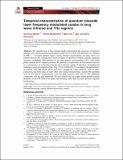Temporal characteristics of quantum cascade laser frequency modulated combs in long wave infrared and THz regions
Author(s)
Burghoff, David Patrick; Hu, Qing
DownloadPublished version (2.921Mb)
Publisher Policy
Publisher Policy
Article is made available in accordance with the publisher's policy and may be subject to US copyright law. Please refer to the publisher's site for terms of use.
Terms of use
Metadata
Show full item recordAbstract
We consider here a time domain model representing the dynamics of quantum cascade lasers (QCLs) generating frequency combs (FCs) in both THz and long wave infrared (LWIR λ = 8-12µm) spectral ranges. Using common specifications for these QCLs we confirm that the free running laser enters a regime of operation yielding a pseudo-randomly frequency modulated (FM) radiation in the time domain corresponding to FCs with stable phase relations in the frequency domain. We provide an explanation for this unusual behavior as a consequence of competition for the most efficient regime of operation. Expanding the model previously developed in [Opt. Eng. 57(1), 011009 (2017)] we analyze the performance of realistic THz and LWIR QCLs and show, despite the vastly different scale of many parameters, that both types of lasers offer very similar characteristics, namely FM operation with an FM period commensurate with the gain recovery time and an FM amplitude comparable with the gain bandwidth. We also identify the true culprit behind pseudo-random dynamics of the FM comb to be spatial hole burning, rather than the more pervasive spectral hole burning.
Date issued
2018-05Department
Massachusetts Institute of Technology. Research Laboratory of Electronics; Massachusetts Institute of Technology. Department of Electrical Engineering and Computer ScienceJournal
Optics Express
Publisher
The Optical Society
Citation
Henry, Nathan et al. “Temporal characteristics of quantum cascade laser frequency modulated combs in long wave infrared and THz regions.” Optics Express, 26, 11 (May 2018): 326697 © 2018 The Author(s)
Version: Final published version
ISSN
2161-2072